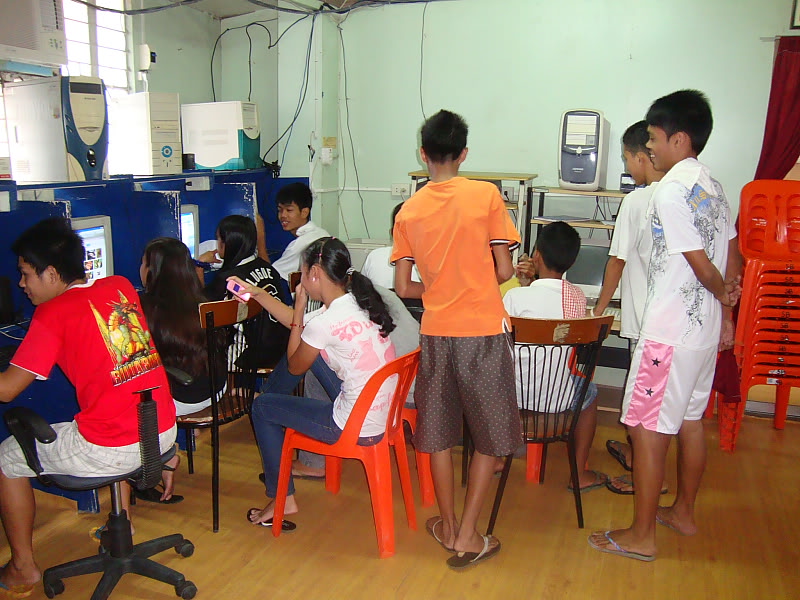Sesame Street: When Is Something Better Than Nothing?
What technology could clearly achieve is providing greater access to education. Technology, as in internet, digital video discs, tapes, or network broadcasting, may cost less in terms of scales. Initial production covers much of the cost. Distribution is not as staggering compared to building so many classrooms and hiring so many instructors. This is especially relevant to places where there are no qualified and effective instructors. Technology may not be that advantageous if online sources are only replacing textbooks. On the other hand, if technology is the only resource available that can provide educational intervention, something is better than nothing.
As an example, Rojiyln Q. Bagabaldo, currently the vice mayor of Paete, Laguna in the Philippines, together with the members of the town council (Sangguniang Bayan), provided computer access to elementary and high school students inside the council's hall. When the council is not in session, students are able to work with computers that have internet access:
 |
| Cyber Library inside Paete's Sangguniang Bayan Hall |
The internet, of course, is not the only promising medium technology has offered for educational intervention. Long before computers are educational television shows. For this particular medium, several decades have already passed, allowing for longitudinal studies that can evaluate technology's impact on education. One such television program, Sesame Street, continues to be broadcast since its first show in 1969. From Wikipedia:
Shortly after creating Sesame Street, its producers developed what came to be called "the CTW model" (named for the show's production company, The Children's Television Workshop), a system of television show planning, production, and evaluation based on collaborations between producers, writers, educators, and researchers. The show was initially funded by government and private foundations but has become somewhat self-supporting due to revenues from licensing arrangements, international sales, and other media. By 2006, there were independently produced versions, or "co-productions", of Sesame Street broadcast in twenty countries. In 2001 there were over 120 million viewers of various international versions of Sesame Street, and by the show's 40th anniversary in 2009, it was broadcast in more than 140 countries.
 |
| Sesame Street 1969 Cast Photo downloaded from Muppet Wikia |
AbstractStudies from the following countries: Australia, Bangladesh, Canada, Egypt, India, Indonesia, Israel and Palestine, Kosovo, Mexico, Nigeria, Northern Ireland, South Africa, Turkey, have been included in this meta-analysis. The list obviously represents a wide spectrum of socio-economic background. The results suggest that Sesame Street does have a positive impact on early childhood education. The effect can be described by a number, 12. This is the percentile gain. Mares and Pan wrote:
Sesame Street is broadcast to millions of children globally, including in some of the world's poorest regions. This meta-analysis examines the effects of children's exposure to international co-productions of Sesame Street, synthesizing the results of 24 studies, conducted with over 10,000 children in 15 countries. The results indicated significant positive effects of exposure to the program, aggregated across learning outcomes, and within each of the three outcome categories: cognitive outcomes, including literacy and numeracy; learning about the world, including health and safety knowledge; social reasoning and attitudes toward out-groups. The effects were significant across different methods, and they were observed in both low- and middle-income countries and also in high-income countries. The results are contextualized by considering the effects and reach of the program, relative to other early childhood interventions.
"The counter-factual causal reasoning implies that the hypothetical average child who watched Sesame Street would be at roughly the 62nd percentile, whereas if that hypothetical average child had not watched, he or she would (by definition) be at the 50th percentile."The percentile ranking is in terms of three categories: "cognitive (knowledge of letters, numbers, colors, shapes, and relationships of size and distance), "learning about the world (earning about the physical and social environment, including knowledge of natural features, health/hygiene, and national/local culture), and "social reasoning and attitudes" (moral reasoning and attitudes toward social out-groups)"
Sesame Street does teach and have some impact beyond just reading and counting. Charlotte Cole in "Why Count von Count Is Obsessed With a New Number" wrote:
Sesame Street will never be a substitute for school, but for many children there is a critical need for effective, affordable educational interventions that either supplement existing efforts or (for children living in under-resourced parts of the world) are the sole access to an intentional early childhood educational experience. That's why, for example, in 2008, researchers found that in Bangladesh the Sesame Street Difference translates into a full year of learning: when children four years old were exposed to Sisimpur (Bangladesh's Sesame Street adaptation) they performed at the same level on tests of reading and math as their five year old peers who had not watched!
Comments
Post a Comment